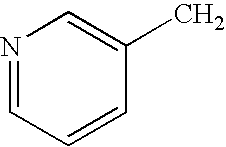Novel process
a technology of bisphosphonic acid and bisphosphonic acid, applied in the field of bisphosphonic acid and salt preparation, can solve the problems of difficult to establish a relationship between the physicochemical nature of a solvent and all of these solvents, and achieve economic and commercial scalable effects
- Summary
- Abstract
- Description
- Claims
- Application Information
AI Technical Summary
Benefits of technology
Problems solved by technology
Method used
Image
Examples
example 1a
Preparation of Risedronic Acid Monosodium Salt
[0091]A mixture of 3-pyridyl-acetic acid or its hydrochloride (20.0 g, 0.145 mol) and phosphorous acid (14.4 g, 0.175 mol) in acetonitrile (300 ml) was heated at a temperature of 55-65° C. and phosphorous trichloride (40.06 g, 0.290 mol) was added slowly under stirring. After completion of the addition, the reaction temperature was raised to 70-75° C. and the reaction continued for 6-9 hours at the same temperature. The reaction mixture was cooled to 60-65° C. and water (300 ml) was added slowly at the same temperature. The reaction temperature was then increased to 90-100° C. and maintained for the next 4-6 hours. The reaction mixture was then cooled to 55-65° C. and the reaction mixture pH was adjusted to 4.3-4.8 with sodium hydroxide solution. The reaction mixture was cooled to 25-35° C. and the aqueous layer containing the product was separated from the upper acetonitrile layer. The aqueous layer was cooled to and maintained at 0-5° ...
example 1b
Preparation of the Hemipentahydrate Form of Risedronic Acid Monosodium Salt
[0092]The crude risedronic acid monosodium salt obtained in example 1a was further purified and crystallized as hemipentahydrate by the following process. Crude risedronic acid monosodium salt (20 g) was dissolved in water (10-16 volume) by heating at 60-70° C. and treated with activated carbon (2-5% w / w of crude sodium risedronate). The reaction mixture was filtered through a Celite® bed. Acetonitrile (or acetone or tetrahydrofuran) was added slowly to the clear filtrate at 60-65° C. to initiate nucleation. The solution was then slowly cooled to ambient temperature (25-28° C.) over a period of 2-3 hours. A solid crystallized out, which was filtered and rinsed with the same solvent as was used for the crystallization. The solid was finally dried in a vacuum oven at 50-55° C. to give sodium risedronate hemipentahydrate as white crystalline solid. Yield: 16 g (80%). Appearance: white crystalline solid. Purity: ...
example 2
Preparation of Pamidronic Acid Monosodium Salt
[0093]A mixture of 3-amino-propionic acid (10.0 g, 0.112 mol) and phosphorous acid (14.0 g, 0.168 mol) in acetonitrile (150 ml) was heated at a temperature of 55-65° C. and phosphorous trichloride (30.8 g, 0.224 mol) was added slowly under stirring. After completion of the addition, the reaction temperature was raised to 70-75° C. and the reaction continued for 6-9 hours at the same temperature. The reaction mixture was cooled to 60-65° C. and water (150 ml) was added slowly at the same temperature. The reaction temperature was then increased to 90-100° C. and maintained for the next 4-6 hours. The reaction mixture was then cooled to 55-65° C. and the reaction mixture pH was adjusted to 4.4-4.8 with sodium hydroxide solution. The reaction mixture was cooled to 25-35° C. and the aqueous layer containing the product was separated from the upper acetonitrile layer. Methanol (60 ml) was added to the aqueous layer and the mixture was cooled t...
PUM
 Login to View More
Login to View More Abstract
Description
Claims
Application Information
 Login to View More
Login to View More - R&D
- Intellectual Property
- Life Sciences
- Materials
- Tech Scout
- Unparalleled Data Quality
- Higher Quality Content
- 60% Fewer Hallucinations
Browse by: Latest US Patents, China's latest patents, Technical Efficacy Thesaurus, Application Domain, Technology Topic, Popular Technical Reports.
© 2025 PatSnap. All rights reserved.Legal|Privacy policy|Modern Slavery Act Transparency Statement|Sitemap|About US| Contact US: help@patsnap.com



